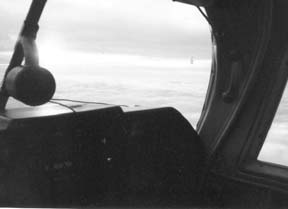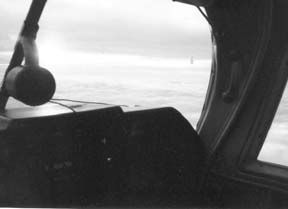
Staff Report
If youre doing a phone briefing, the Flight Service specialist will raise the niggling questions first: what altitude? For the low-and-slow crowd, its usually some easy choice under 10,000 feet. The decision is more involved for pilots of high performance or turbocharged airplanes that can easily climb into the mid-altitudes – above 12,000 feet but below 18,000 feet or FL200, tops.
There are compelling reasons to fly at these altitudes. The weather is often better, the tailwinds are stronger and, for turbocharged airplanes, higher true airspeeds may make it worth climbing that high. On the other hand, additional speed might not be found by clawing your way into the 20s, thus the mids are a nice place to be. High altitudes are sometimes worth the effort even for non-turbocharged airplanes, if the winds are right.
In making the decision on what altitude to fly, consider four factors: how fast will the airplane fly, what will the weather be at those altitudes, what kind of IFR routing is available. If all that looks favorable, is it worth the slight physiological risks of cruising where the air is thin?
Performance
Lets consider turbocharged airplanes first. For this exercise, well use a Cessna 210. With a 285-HP Continental IO-520, the non-turbocharged Centurion is a strong cruiser up to about 10,000 feet, where it will motor along at 160 knots; above that, power and true airspeeds decline. The turbocharged version of the same airplane runs about the same speeds below 10,000 feet but starts to pull away above that altitude. In the mid-teens, the turbo 210 is a 170-knot cruiser, increasing to 182 knots in the 20s.
Unfortunately, what turbocharging gives it can also take away, due to a wind gradient that rises faster than the turbocharged airplanes rising true airspeed gradient. Using the example of a mid-winter trip from Boston to Cleveland – an easy stretch for the 210 – it might not be worth going high for the westbound trip. The winds at 8,000 are 280 degrees at 25 knots, right off the nose. At 16,000 feet, theyre a little more northerly – 310 degrees at 55 knots. And in the low 20s, winds are 330 degrees at 65 knots.
Days like this werent made for westbound trips in turbocharged airplanes. At 8,000 feet, groundspeed in both versions of the airplane would be about 137 knots; not a crawl but not impressive, either. Climbing to 16,000 in the turbo version would yield 175 knots TAS against a 45-knot headwind component for a groundspeed of 130 knots. If turbulence or ice isnt in the equation, climbing high is a loser. Youll burn more fuel just to go slower.
Westbound for a turbocharged airplane, a good compromise is often 10,000 to 12,000 feet. In the example given here, with winds from 300 degrees at 40 knots and 170 knots TAS, those altitudes might get you above clouds and turbulence with minimal give-up on the groundspeed.
Eastbound, of course, the logic reverses. Look at 19,000 feet eastbound. The groundspeed would be 220 knots for a trip time of just over two hours. It doesnt get much better. Would it be worth climbing to, say, FL240 to make the most of a good thing? The true airspeed would be three knots higher but the wind shears more off the wing so the groundspeed is about the same. A toss-up, but probably not worth the extra climb.
In a normally aspirated 210 or any high performance aircraft thats not too heavy, climbing into the low to mid-teens is often worth the effort eastbound. In this scenario, at 15,000 feet, the non-turbocharged 210 trues at a respectable 150 knots. Climbing that high is worth the effort for 180-knot groundspeed.
On the proverbial calm day, its debatable whether high-altitude flight is inherently more efficient in a non-turbocharged airplane, although it generally is in a turbocharged airplane because you go so much faster on almost the same fuel. But these efficiency gains can be wiped out by a long climb to altitude where the wind may not be what you expected. Wind rules the decision. A computer flight planner with altitude optimization will give you useful numbers.
Weather
Weather in the mid altitudes is obviously different than what youd expect to find at, say, 8,000 feet. The air is drier, the winds are stronger and this is where the steering currents for thunderstorms do their dirty work. Its difficult to generalize, but on most flights a GA piston is likely to make, clouds tops can be left below somewhere in the teens. Or youll find clear space between layers, if icing is a concern. But anyone who has flown the flight levels much knows that its not unheard of to see clouds from the ground all the way to the flight levels or higher with indeterminate layers.
During the summer, avoiding isolated thunderstorms visually is easier in the teens because youre above the haze layer and can see storms at great distances. A tiny course correction will avoid a storm 40 miles away. Its also not unusual to watch distant storms dissipate before you get to them.
With a standard lapse rate during the summer, the freezing level in much of the U.S. hovers around 16,000 to 20,000 feet, variable with the amount of moisture in the air, which rises and imparts heat to the upper altitudes. This means that during high summer, ice in the mid-teens is not much of worry but it will be a concern – a certainty – in rising clouds in the high teens and 20s. Puffy cumulus can easily be lifted into the teens without being thunderstorms; their tops are likely to be intense ice generators, not to mention turbulent.
In addition to ice, the lightning hazard is to believed to be somewhat greater at the freezing level and below than above it. Most reports of lightning strikes are clustered between 10,000 and 15,000 feet. Most strikes occur in cloud but some have been reported clear of clouds.
During the winter, climbing into the mids will often – but not always – get you into clear air above any potential icing. The downside of this is that youll have to climb through the tops where the most intense icing is likely to be found. If climbing through many thousands of feet of cloud is necessary during the winter, the mid to high teens may offer an altitude in which all the visible moisture is already frozen, rather than supercooled.
This is evidently the source of ancient wisdom that its always better to climb when you encounter ice, because youll eventually find air too cold to support icing. Theres no question that theres air up there somewhere where structural ice wont form. The problem with this flawed rule of thumb is that you may have to climb through the mother lode of rime to reach it, if you can get there at all. Before climbing or descending to avoid ice – or any hazard, for that matter – its a good idea to know whats up there or down there, preferably via Pirep.
Breathing Up There
For this discussion, well ignore the FAR requirements for oxygen use. Theyre probably not conservative enough for many pilots who prefer and probably ought to be using oxygen at 10,000 feet and higher. Hypoxia is a highly individual phenomenon and the FAAs Civil Aeromedical Institute says altitude chamber research reveals that it doesnt always affect the same person the same way at each exposure to high altitude.
A chart of the standard atmosphere shows that in the mid-altitudes, the pressure is half what it is on the surface – 7.96 psi versus 14.69 psi. Climb to 22,000 feet, and the pressure drops to 6.21 psi. Although thats a less precipitous decline, its a mistake to think that physiologically, theres not much difference between 16,000 feet and 22,000 feet.
One way of measuring the ultimate impact of hypoxia is the time of useful consciousness, also called effective performance time. Below 20,000 feet, its considered to be 30 minutes or more, according to CAMI. At 22,000, EPT declines to 5 to 10 minutes but varies with individual. At 25,000 feet, EPT is 3 to 5 minutes but, again, could be substantially less for some individuals. And EPT doesnt mean you wont be impaired long before that.
Theres no argument about the need for supplemental oxygen at these altitudes, but theres room for debate about which altitude represents the best compromise between risk and the advantages of flying high.
And make no mistake, there is some risk. Even in good oxygen systems, regulators and flow meters fail, valves freeze, lines plug up. The higher you fly, the greater the risk that these failures will put you into physiological extremis, which is why it might not make sense to cruise at 22,000 feet when you can remain at 16,000 feet for almost the same performance. Cruising in the mid-altitudes puts less make-or-break pressure on your oxygen delivery system, which translates to a more forgiving flight environment. Absent considerations about wind and weather, lower is better than higher physiologically.
Fortunately, the general aviation industry has gotten ever more sophisticated with its oxygen equipment. You can buy portable systems with mechanical or electronic conservers that will quadruple oxygen endurance. Pulse oximeters, once a device found only in hospital operating rooms, can now be bought for under $400, and having one aboard will put hard and useful numbers on how well or poorly your oxygen system is working. If you know the symptoms of hypoxia – and every pilot flying where oxygen is needed should know these symptoms – an oximeter can confirm your suspicions. These small and affordable instruments can also serve as valuable routine how-goes-it monitors; think of them as engine analyzers for your body.
IFR or VFR?
Flying below 18,000 feet offers the choice of VFR or IFR, flexibility that can shave a lot from total trip time. Further, in some airspace, the mid-altitudes arent as congested as lower or higher altitudes, thus routing options are greater. Weather permitting, VFR in the mids gives you the widest choice of altitudes and routing.
A second attractive option is a VFR departure with an IFR pick-up enroute.
In the northeast, for example, its not unusual for a turbocharged piston airplane to be held below 10,000 feet for many miles. Regardless of how congested the airspace happens to be at that time, this is done to meet the terms of the preferential IFR routing structure. Its frustrating for a pilot who wants to catch favorable winds.
Flying the entire trip VFR removes this obstacle, of course, and makes every altitude right up to 17,500 feet available for cruise. If weather permits, a VFR departure with an IFR pick-up enroute is also a good work around for unfavorable altitude restrictions. Clear of Class B areas and away from arrival and departure corridors, the airspace is usually clear sailing for an unrestricted climb to the mid altitudes.
IFR pick-ups in the mid-altitudes are usually easier, too, since youre dealing with Centers, whose host computers originate IFR flight plans electronically. A Center controller can easily find a pre-filed IFR flight plan or can provide one on the fly with less fuss than can a terminal controller. In most parts of the country, filed altitudes in the mid to high teens will permit direct, off-airways routing, something thats less likely at lower altitudes. The minor catch is that you may have to fly STARs as you transition back into terminal airspace. But theres a solution for that, too: weather permitting, cancel IFR and head to the destination VFR.
Also With This Article
“Performance in the Mids”




